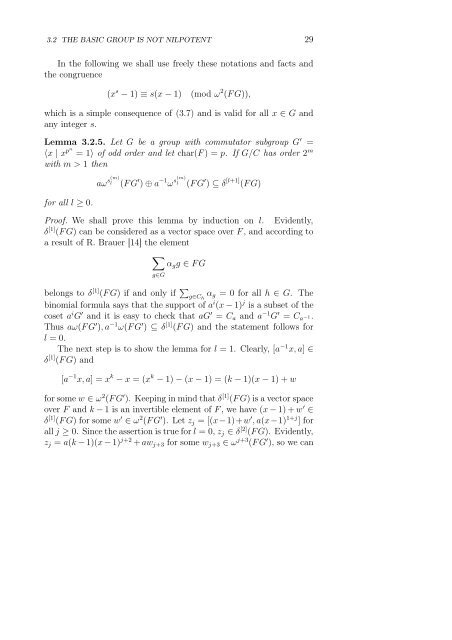On the Derived Length of Lie Solvable Group Algebras
On the Derived Length of Lie Solvable Group Algebras
On the Derived Length of Lie Solvable Group Algebras
Create successful ePaper yourself
Turn your PDF publications into a flip-book with our unique Google optimized e-Paper software.
3.2 THE BASIC GROUP IS NOT NILPOTENT 29<br />
In <strong>the</strong> following we shall use freely <strong>the</strong>se notations and facts and<br />
<strong>the</strong> congruence<br />
(x s − 1) ≡ s(x − 1) (mod ω 2 (F G)),<br />
which is a simple consequence <strong>of</strong> (3.7) and is valid for all x ∈ G and<br />
any integer s.<br />
Lemma 3.2.5. Let G be a group with commutator subgroup G ′ =<br />
〈x | xpn = 1〉 <strong>of</strong> odd order and let char(F ) = p. If G/C has order 2m with m > 1 <strong>the</strong>n<br />
for all l ≥ 0.<br />
aω s(m)<br />
l (F G ′ ) ⊕ a −1 ω s(m)<br />
l (F G ′ ) ⊆ δ [l+1] (F G)<br />
Pro<strong>of</strong>. We shall prove this lemma by induction on l. Evidently,<br />
δ [1] (F G) can be considered as a vector space over F , and according to<br />
a result <strong>of</strong> R. Brauer [14] <strong>the</strong> element<br />
<br />
αgg ∈ F G<br />
g∈G<br />
belongs to δ [1] (F G) if and only if <br />
g∈Ch αg = 0 for all h ∈ G. The<br />
binomial formula says that <strong>the</strong> support <strong>of</strong> ai (x − 1) j is a subset <strong>of</strong> <strong>the</strong><br />
coset aiG ′ and it is easy to check that aG ′ = Ca and a−1G ′ = Ca−1. Thus aω(F G ′ ), a−1ω(F G ′ ) ⊆ δ [1] (F G) and <strong>the</strong> statement follows for<br />
l = 0.<br />
The next step is to show <strong>the</strong> lemma for l = 1. Clearly, [a−1x, a] ∈<br />
δ [1] (F G) and<br />
[a −1 x, a] = x k − x = (x k − 1) − (x − 1) = (k − 1)(x − 1) + w<br />
for some w ∈ ω 2 (F G ′ ). Keeping in mind that δ [1] (F G) is a vector space<br />
over F and k − 1 is an invertible element <strong>of</strong> F , we have (x − 1) + w ′ ∈<br />
δ [1] (F G) for some w ′ ∈ ω 2 (F G ′ ). Let zj = [(x−1)+w ′ , a(x−1) 1+j ] for<br />
all j ≥ 0. Since <strong>the</strong> assertion is true for l = 0, zj ∈ δ [2] (F G). Evidently,<br />
zj = a(k − 1)(x − 1) j+2 + awj+3 for some wj+3 ∈ ω j+3 (F G ′ ), so we can


